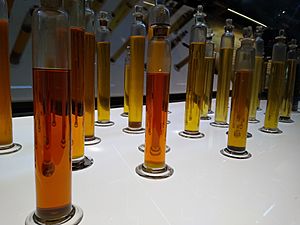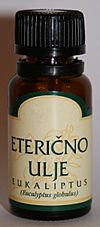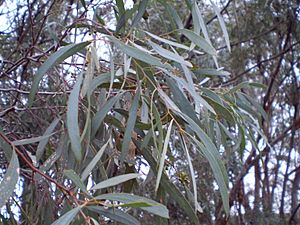Eucalyptus oil facts for kids

Eucalyptus oil is a special oil made from the leaves of Eucalyptus trees. These trees are mostly found in Australia, but they are now grown all over the world. Eucalyptus oil has been used for a very long time in many different ways. People use it in medicine, as a disinfectant to kill germs, to keep bugs away, to add flavor or fragrance to products, and even for industrial purposes. To get the oil, the leaves of certain eucalyptus trees are heated with steam, which helps to extract the oil.
Contents
What is Eucalyptus Oil and How is it Made?
Eucalyptus oils are usually grouped into three main types based on what they are used for: medicinal (for health), perfumery (for smells), and industrial (for factories). The most common type is called "oil of eucalyptus." It's usually a clear liquid (but can turn yellow over time) with a strong, fresh, woody smell, a bit like camphor. This type of oil has a lot of a chemical called cineole.
Even though eucalyptus trees are from Australia, China makes about 75% of the world's eucalyptus oil. However, much of this actually comes from a different plant called camphor laurel, not true eucalyptus. Other important countries that produce real eucalyptus oil include South Africa, Portugal, Spain, Brazil, Australia, Chile, and Eswatini.
Most of the world's eucalyptus oil comes from the Eucalyptus globulus tree. But two other types, Eucalyptus kochii and Eucalyptus polybractea, have the most cineole, sometimes as much as 80% to 95%. For eucalyptus oil to be used in medicines, it usually needs to have at least 70% cineole. Sometimes, oils with less cineole are processed to reach this higher standard. Back in 1991, people estimated that about 3,000 tons of medicinal eucalyptus oil were made each year, plus another 1,500 tons for perfumes.
Some eucalyptus trees also produce oils that don't have much cineole. These oils might contain other chemicals like piperitone, phellandrene, citral, methyl cinnamate, and geranyl acetate.
How People Use Eucalyptus Oil
Eucalyptus Oil in Herbal Medicine
The European Medicines Agency, which is like a health authority, has said that traditional medicines using eucalyptus oil can help with coughs from a common cold. It can also help ease muscle pain in specific areas of the body.
Eucalyptus Oil as a Bug Repellent
Eucalyptus oil that contains a lot of cineole is used to keep insects away. It can also be used as a biopesticide, which means it helps control pests in a natural way. In the U.S., eucalyptus oil was first approved in 1948 to be used against insects and tiny mites.
Eucalyptus Oil for Flavor and Scent
Eucalyptus oil is used to add flavor to certain foods. When used in very small amounts (like 0.002%), cineole-based eucalyptus oil can be found in things like baked goods, confectionery (sweets), meat products, and drinks. It can also help stop germs that spoil food. Other types of eucalyptus oil, like those from peppermint gum, strawberry gum, and lemon ironbark, are also used for flavor.
Eucalyptus oil is also a popular fragrance because it has a fresh and clean smell. You can find it in soaps, detergents, lotions, and perfumes. Because it helps clean things, eucalyptus oil is also used in mouthwashes to make your breath fresh.
Industrial Uses for Eucalyptus Oil
Studies have shown that cineole-based eucalyptus oil (when it's 5% of a mixture) can help prevent problems when ethanol is mixed with petrol for fuel. Eucalyptus oil also has a good octane rating, which means it could be used as a fuel by itself. However, it's currently too expensive to produce it just for fuel.
Eucalyptus oils that contain phellandrene and piperitone have been used in mining. They help separate sulfide minerals using a process called flotation.
Eucalyptus Oil for Cleaning
Eucalyptus oil has natural properties that fight germs and clean things. This makes it useful for cleaning around the house. It's often found in laundry products, especially those for washing wool. It's also good at dissolving grease and sticky messes.
Is Eucalyptus Oil Safe?
When used in small amounts, like in food flavorings or medicines at the right dose, cineole-based eucalyptus oil is generally safe for adults. However, if you swallow too much or put too much on your skin, it can be harmful. In Australia, eucalyptus oil is one of the essential oils that has caused many cases of poisoning, especially in children. Between 2014 and 2018, there were over 2,000 reported cases of essential oil poisoning in New South Wales, with eucalyptus oil being a major cause.
For an adult, swallowing between 0.05 mL and 0.5 mL of pure eucalyptus oil per kilogram of body weight can be dangerous. Children are more sensitive to poisons absorbed through the skin because their bodies are smaller compared to their skin surface. Serious poisoning has happened in children after they swallowed just 4 mL to 5 mL of eucalyptus oil.
Eucalyptus oil can also be dangerous for pet cats. It can make them unsteady when they walk, drool a lot, and show other signs of being unwell.
History of Eucalyptus Oil

Aboriginal people in Australia traditionally used infusions (like a tea) made from eucalyptus leaves to treat body pains, sinus problems, fever, and colds. These infusions contained eucalyptus oil.
In 1788, Dennis Considen and John White, who were surgeons on the First Fleet (the first ships to bring settlers to Australia), made eucalyptus oil. They got it from Eucalyptus piperita trees growing near Port Jackson. They used it to treat the convicts and marines. Early settlers also extracted eucalyptus oil, but it took some time before it was sold commercially.
Baron Ferdinand von Mueller, a botanist from Victoria, Australia, spoke highly of eucalyptus as a disinfectant in areas where fevers were common. He also encouraged Joseph Bosisto, a Melbourne pharmacist, to look into selling the oil. Bosisto started the first commercial eucalyptus oil business in 1852 near Dandenong, Victoria, Australia. He set up a plant to distill the essential oil from a type of Eucalyptus radiata tree that had a lot of cineole. This is why the cineole-rich oil became known as the standard "oil of eucalyptus," and "Bosisto's Eucalyptus Oil" is still a brand today.
A French chemist named F. S. Cloez identified and named the main part of E. globulus oil as eucalyptol, also known as cineole. By the 1870s, oil from Eucalyptus globulus, or Tasmanian blue gum, was being sold all over the world and became very popular. Surgeons started using eucalyptus oil as an antiseptic during surgery in the 1880s.
The eucalyptus oil industry became very important in the box-ironbark forests of Victoria after the Victorian gold rush in the 1870s. People often called the oil Australia's natural wonder. It was sent to a growing international market, mostly for medical uses. Eucalyptus oil was in especially high demand during the global influenza pandemic of 1918-19. A distillation plant was even set up by the Forests Commission Victoria near Bendigo in 1926. Edwin James Semmens, the head of the Victorian School of Forestry, did a lot of important research into what eucalyptus oil is made of. His old steam extraction kilns are now in the museum at the school.
The Australian eucalyptus oil industry was at its biggest in the 1940s, especially in the central goldfields region of Victoria, like Inglewood. Later, as eucalyptus trees were planted worldwide for timber, more eucalyptus oil became available as a side product. By the 1950s, it became too expensive to make eucalyptus oil in Australia. It couldn't compete with cheaper oils from Spain and Portugal, which were closer to the European market. Now, most commercial eucalyptus oil comes from outside Australia, though Australia still produces high-quality oils, mainly from blue mallee (E. polybractea) trees.
Types of Eucalyptus Trees Used for Oil
Commercial eucalyptus oils that contain a lot of cineole are made from several different types of Eucalyptus trees:
- Eucalyptus cneorifolia
- Eucalyptus dumosa
- Eucalyptus globulus
- Eucalyptus goniocalyx
- Eucalyptus horistes
- Eucalyptus kochii
- Eucalyptus leucoxylon
- Eucalyptus oleosa
- Eucalyptus polybractea
- Eucalyptus radiata
- Eucalyptus sideroxylon
- Eucalyptus smithii
- Eucalyptus tereticornis
- Eucalyptus viridis
Some eucalyptus trees produce oils that do not have much cineole:
- Eucalyptus dives (phellandrene or piperitone types)
- Eucalyptus elata (piperitone type)
- Eucalyptus macarthurii (geranyl acetate type)
- Eucalyptus olida (methyl cinnamate type)
- Eucalyptus radiata (phellandrene type)
- Eucalyptus staigeriana (citral, limonene types)
The tree that used to be called lemon eucalyptus, Eucalyptus citriodora, is now known as Corymbia citriodora. It produces an oil that has a lot of citronellal.



